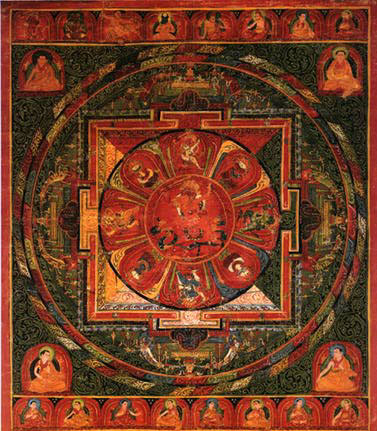| Raktayamari Mandala gshed-dmar-gyi dkyil-'khor Central Tibet, Second half, 16th century 31.4 x 27.6 cm |
|
Raktayamari, the red Yamari ("enemy of Yama"), embraces his consort at the center of this mandala.1 He holds a skullcup in one hand and a staff surmounted by a yellow head "still wet with blood" in the other; his consort holds aloft the chopper.2 As is
fitting his role as an aspect of the deity Yamantaka ("Conqueror of Yama"), Raktayamari tramples on the Hindu god of death, Yama, who lies supine on a red buffalo. An eight-petaled lotus holds his sacred assembly; Mohayamari and consort (E), Matsaryayamari and consort (S), Ragayamari and consort (W), Irsyayamari and consort (N). Four skullcups atop vases, holding perfume and nectar, mark the intermediate points of the compass. An inscription in gold at the bottom of the painting states: "Salutations to Yamari! I beseech you to accept me, the tantric practitioner (vidyadhara) Lhachok Senge (lha-mchog seng-ge), as your follower.î3 Lhachok Senge was a member of the Sakya monaste ry of Ngor (founded 1429), during or slightly later than the time of the tenth abbot of Ngor, Konchok Lundrup (dkon-mchog lhun-grub, 1497-1557).4 Among the historical figures surrounding the Mandala proper is the Indian yogic adept Virupa (act. early ninth century), who transmitted teachings associated with Raktayamari which eventually became popular in Tibet. Indeed, this particular form of Raktay amari's mandala may be traced to Virupa's teachings.5 1 An inscription on the painting reverse identifies the central figure as Raktayamari: shed [read: gshed]-dmar. 2 Following a description in the Sadhanamala. See Bhattacharyya, The Indian Buddhist Iconography, p. 167. 3 Ya-ma-ri na-ma: bdag rig-pa'i-dzin-pa lha-mchog seng-ge rjes-su gzung-du gsol// 4 A painting in the Essen collection includes an inscription stating it was made for Lhachok Senge, as his thugs-dam or "meditative commitment." See G.W. Essen and T.T. Thingo, Die Gotter des Himalaya vol 2, pl. 228. 5 See Sonam Gyatso, Tibetan Mandalas. The Ngor Collection, pl. 50.
|
